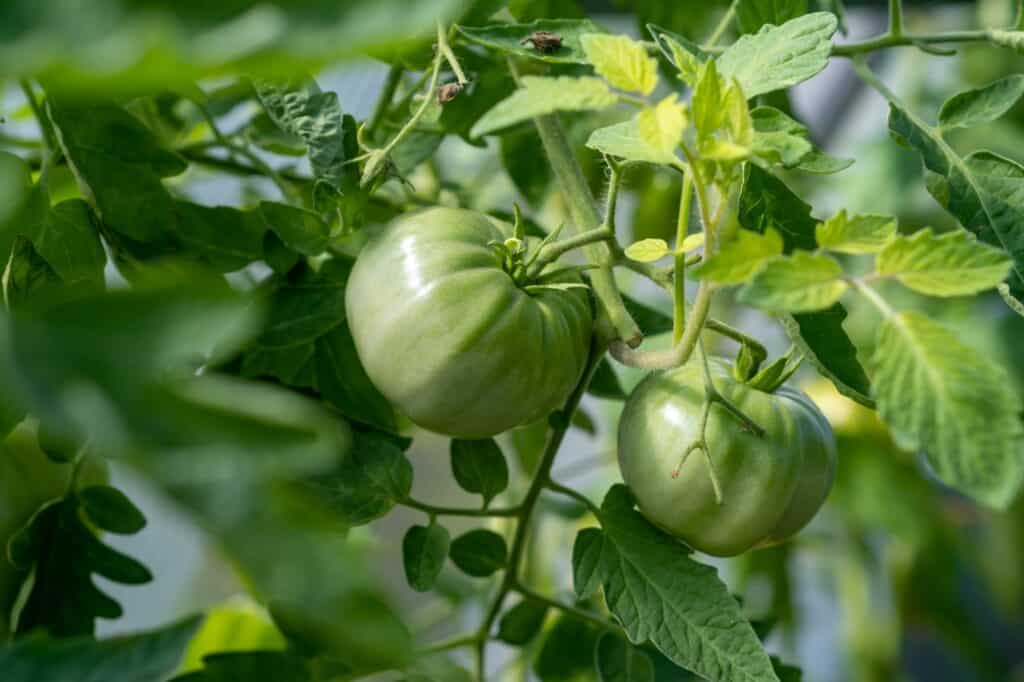White spots on tomato leaves can be a common issue for gardeners. These spots can appear for various reasons, including diseases, pests, and environmental factors. Understanding the cause of white spots on tomato leaves is crucial in preventing and treating the issue effectively.
Common diseases that cause white spots on tomato leaves include powdery mildew and late blight. Powdery mildew is caused by several types of fungi and is carried by air currents and insects such as aphids.
Late blight, on the other hand, is caused by the pathogen Phytophthora infestans and thrives in wet, humid conditions. It can cause extensive damage to crops and, in some cases, can lead to plant death.
Environmental factors leading to white spots on tomato leaves can include high humidity levels, extreme temperatures, and improper watering.
Pests such as stinkbugs can also cause white spots on tomato leaves. Understanding the cause of white spots on tomato leaves can help gardeners prevent and treat the issue effectively.
Key Takeaways
- White spots on tomato leaves can be caused by diseases, pests, and environmental factors.
- Common diseases that cause white spots include powdery mildew and late blight.
- Preventing and treating white spots on tomato leaves requires understanding the cause and taking proper care of tomato plants.
How to Fix White Spots on Tomato Leaves: 3 Reasons and Treatments
Tomato Yellow Leaves with Brown Spots: 5 Causes, Treatments & Best Care Tips
Tomato Plants with Yellow Leaves and Black Spots: 5 Causes, Solutions & Best Care Tips
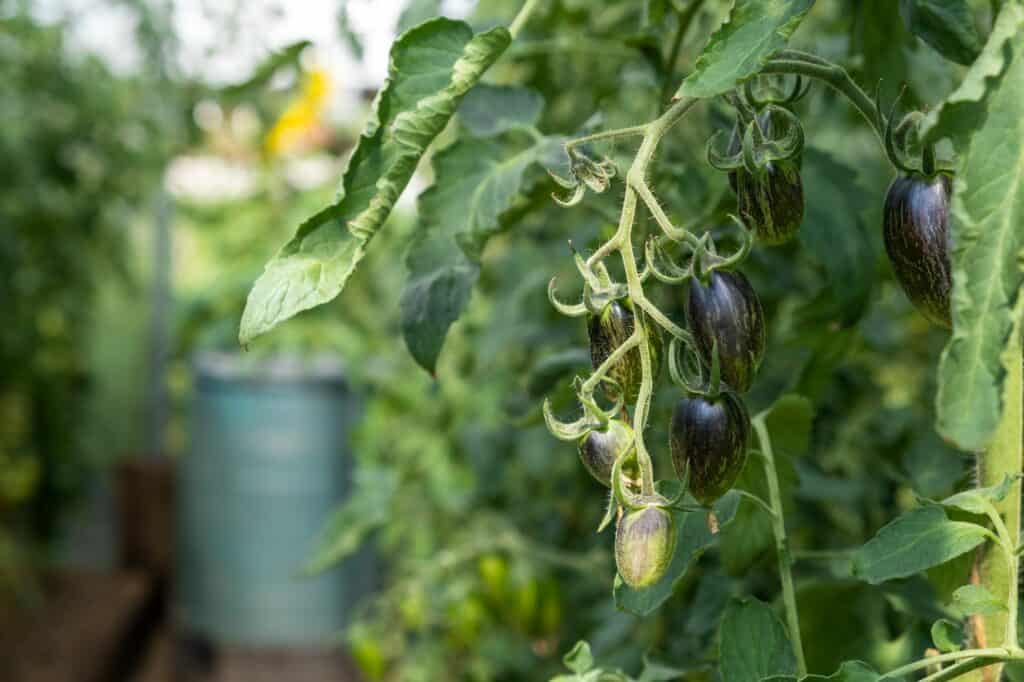
Understanding White Spots on Tomato Leaves
White spots on tomato leaves are a common issue that many gardeners face. These spots can be caused by a variety of factors, including diseases, pests, and environmental conditions.
In this section, we will explore the causes of white spots on tomato leaves and how to prevent and treat them.
Causes of White Spots on Tomato Leaves
Powdery Mildew
Powdery mildew is a fungal disease that affects many plants, including tomatoes. It is characterized by white, powdery spots on the leaves, stems, and fruit of the plant.
Powdery mildew is most prevalent in warm, humid weather conditions, and it can spread quickly from plant to plant.
Late Blight
Late blight is another fungal disease that affects tomatoes and can cause white spots on the leaves.
It is caused by the pathogen Phytophthora infestans and thrives in wet, humid conditions. Late blight can cause extensive damage to crops and, in some cases, can lead to plant death.
Insect Infestations
Insect infestations can also cause white spots on tomato leaves. Aphids, whiteflies, and spider mites are common pests that can cause damage to tomato plants.
These insects feed on the leaves and can cause discoloration and white spots.
Environmental Conditions
Environmental conditions such as high humidity, overwatering, and poor air circulation can also contribute to white spots on tomato leaves.
Overwatering can lead to a buildup of moisture on the leaves, which can promote the growth of fungi and other pathogens.
Prevention and Treatment
Preventing white spots on tomato leaves starts with good plant care. Here are some tips to prevent and treat white spots on tomato leaves:
- Plant resistant varieties of tomatoes.
- Provide good air circulation by spacing plants properly and pruning as needed.
- Water plants at the base to avoid getting water on the leaves.
- Remove infected leaves and dispose of them properly.
- Apply fungicides and insecticides as needed.
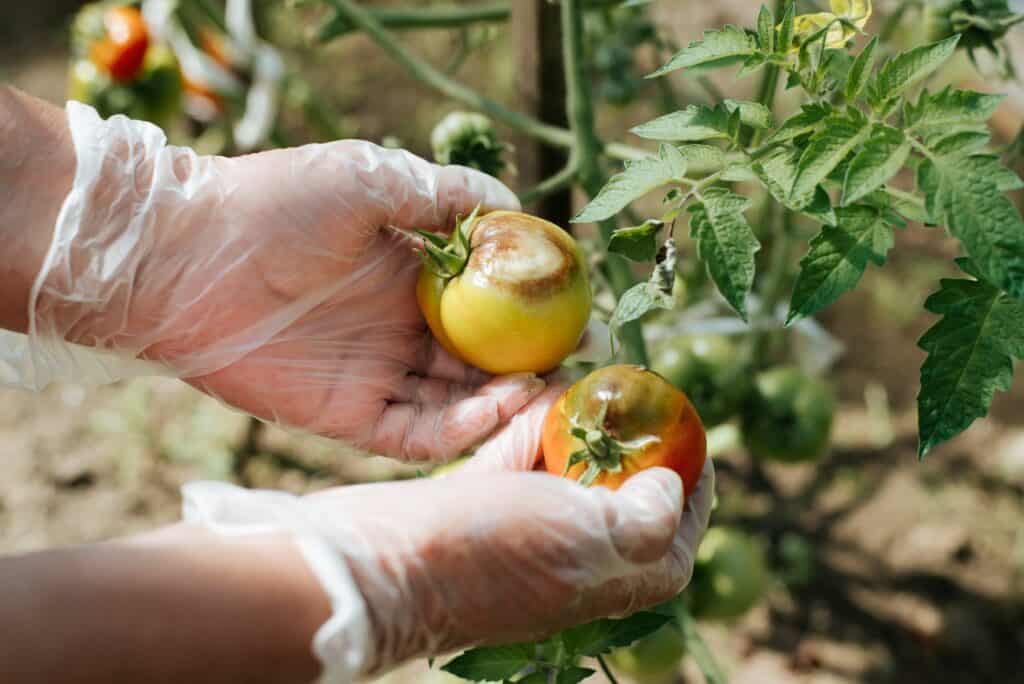
What Causes White Spots on Tomato Leaves
Tomato plants are susceptible to various diseases that can cause white spots on their leaves. Some of the most common diseases that cause white spots on tomato leaves are powdery mildew, septoria leaf spot, late blight, bacterial speck, bacterial canker, and Alternaria.
- Powdery Mildew
Powdery mildew is a fungal disease that is caused by several types of fungi. It is a common disease in tomato plants, and it is often carried by air currents and insects such as aphids.
Powdery mildew is most prevalent when the temperatures are hot and dry or hot and humid for an extended period. The disease appears as a white, powdery substance on the leaves of the plant. As the disease progresses, the leaves may turn yellow and fall off.
- Septoria Leaf Spot
Septoria leaf spot is a fungal disease that is caused by the fungus Septoria lycopersici. It is a common disease in tomato plants, and it is most prevalent in warm, wet weather.
The disease appears as small, circular patches with a grayish-white center and dark edges. Tiny black spots may show up in the center of each blemish. Affected leaves turn yellow, wither, and fall off.
- Late Blight
Late blight is a fungal disease that is caused by the fungus Phytophthora infestans. It is a serious disease that can cause significant damage to tomato plants.
The disease appears as a white, fluffy substance on the leaves of the plant. As the disease progresses, the leaves may turn yellow and fall off. Late blight can also affect the fruit of the plant, causing it to rot.
- Bacterial Speck
Bacterial speck is a bacterial disease that is caused by the bacterium Pseudomonas syringae pv. tomato.
The disease appears as small, black spots on the leaves of the plant. As the disease progresses, the spots may become larger and more numerous, causing the leaves to turn yellow and fall off.
- Bacterial Canker
Bacterial canker is a bacterial disease that is caused by the bacterium Clavibacter michiganensis subsp. michiganensis.
The disease appears as small, white spots on the leaves of the plant. As the disease progresses, the spots may become larger and more numerous, causing the leaves to turn yellow and fall off.
- Alternaria
Alternaria is a fungal disease that is caused by the fungus Alternaria solani. The disease appears as small, brown lesions mostly on the older foliage.
Spots enlarge, and concentric rings in a bull’s-eye pattern may be seen in the center of the diseased area. The tissue surrounding the spots may turn yellow.
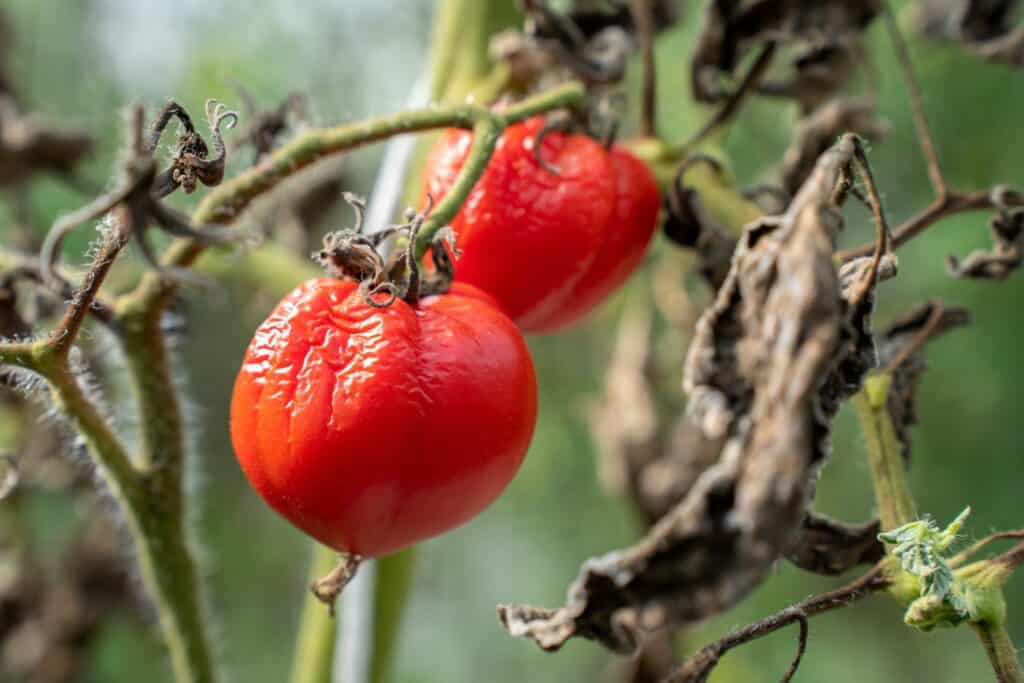
Environmental Factors Leading to White Spots
White spots on tomato leaves can be caused by a variety of environmental factors. Understanding these factors can help gardeners prevent and treat white spots on their tomato plants.
Sun Scalding
Tomato plants that are exposed to direct sunlight for long periods of time can develop white spots on their leaves. This is known as sun scalding.
The intense heat and UV rays from the sun can damage the plant’s cells, causing the leaves to turn white. To prevent sun scalding, gardeners should provide their tomato plants with some shade during the hottest parts of the day.
Temperature Extremes
Tomato plants are sensitive to temperature extremes. When temperatures get too high or too low, the plants can develop white spots on their leaves.
This is because extreme temperatures can cause stress on the plant, which can lead to cell damage.
To prevent temperature-related white spots, gardeners should provide their tomato plants with consistent temperatures and avoid exposing them to extreme heat or cold.
High Humidity Levels
High humidity levels can also cause white spots on tomato leaves. When the air is too humid, it can create a favorable environment for fungal growth.
Fungal infections like powdery mildew can cause white spots to appear on the leaves. To prevent humidity-related white spots, gardeners should ensure good air circulation around their tomato plants and avoid over-watering.
Overwatering
Overwatering can also cause white spots on tomato leaves. When tomato plants are over-watered, their leaves can become waterlogged and develop white spots.
To prevent overwatering-related white spots, gardeners should water their tomato plants only when necessary and avoid letting water pool around the base of the plant.
Nutrient Deficiency
Nutrient deficiencies can also cause white spots on tomato leaves. Calcium, magnesium, nitrogen, and phosphorus are all essential nutrients for tomato plants.
A deficiency in any of these nutrients can cause white spots to appear on the leaves. To prevent nutrient-related white spots, gardeners should ensure that their tomato plants are receiving the proper nutrients through fertilization and soil amendments.
Pests That Cause White Spots
White spots on tomato leaves can also be caused by pests, such as aphids and stinkbugs. These pests can cause physical damage to the plant, which can lead to the development of white spots.
Aphids
Aphids are small insects that feed on the sap of tomato plants. They are usually green or black and can be found on the undersides of leaves.
Aphids can cause the leaves to curl and develop yellow spots. They also secrete a sticky substance called honeydew, which can attract other pests such as ants.
To control aphids, it is important to remove any infected leaves and use a natural insecticide such as neem oil or insecticidal soap.
Ladybugs and lacewings are natural predators of aphids and can also be introduced to the garden to control their population.
Stinkbugs
Stinkbugs are another common pest that can cause white spots on tomato leaves. They are brown or green in color and have a distinct shield shape.
Stinkbugs feed on the fruit of the tomato plant and can cause it to become misshapen and develop white spots.
To control stinkbugs, it is important to remove any infected fruit and use a natural insecticide such as pyrethrin. Handpicking stinkbugs off the plant is also an effective method of control.
Prevention and Treatment of White Spots
There are a few things you can do to prevent and treat white spots on tomato leaves. Proper watering techniques, pruning, fungicide use, nutrient management, and resistant varieties are all important factors to consider.
Proper Watering Techniques
Watering at the base of the plant with a drip irrigation system or soaker hose can help prevent the spread of fungal diseases like powdery mildew.
It is also important to avoid getting water on the leaves, as this can create a humid environment that is conducive to fungal growth.
Pruning
Pruning can help increase air circulation and reduce humidity around the plants, which can help prevent fungal growth.
It is important to remove any infected leaves or branches as soon as possible to prevent the spread of the disease.
Fungicide Use
Fungicides can be used to treat white spots on tomato leaves. Neem oil is an organic fungicide that can help prevent powdery mildew, as well as mealybugs, aphids, and whiteflies. Copper fungicide is another option that can be effective against fungal diseases.
Nutrient Management
Proper nutrient management is essential for healthy tomato plants. Fertilizers should be used in moderation, as over-fertilization can lead to nutrient imbalances that can make plants more susceptible to disease.
Resistant Varieties
Choosing resistant varieties of tomatoes can help prevent the spread of fungal diseases. Some varieties are naturally resistant to powdery mildew and other fungal diseases, so it is important to do your research when selecting tomato plants for your garden.
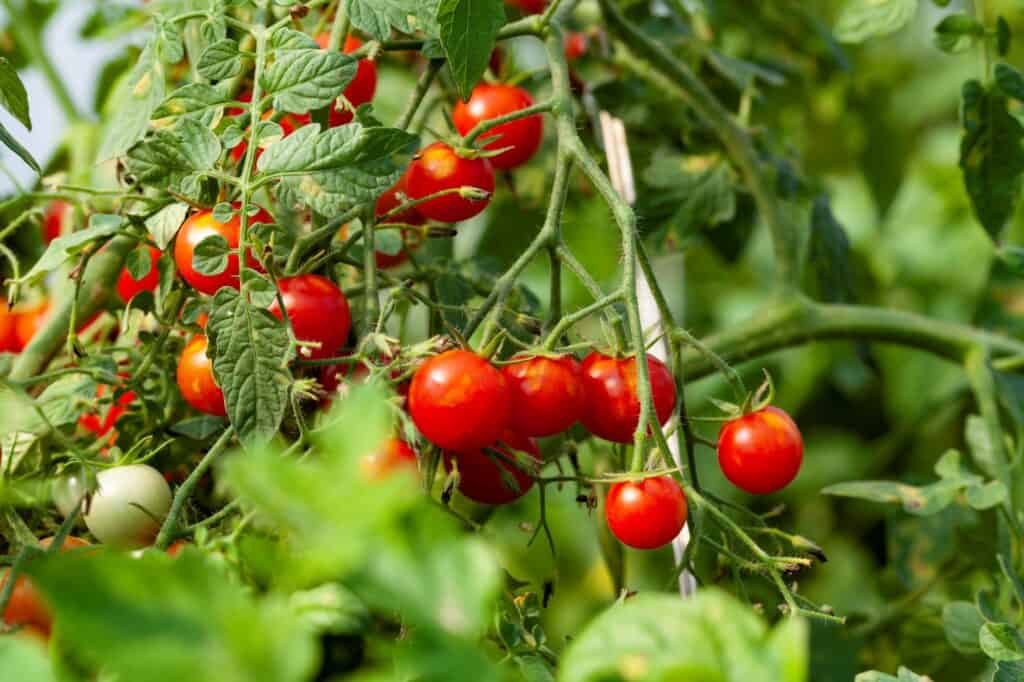
Tomato Plant Care for Healthy Growth
Growing healthy tomato plants requires proper care and maintenance. Here are some tips to ensure your tomato plants grow strong and produce delicious fruit.
Transplanting
Transplanting young tomato seedlings to their final location is a crucial step in their growth. It is recommended to transplant them after the last frost date in your area.
When transplanting, make sure to bury the stem up to the first set of leaves to encourage root growth. This will also help the plant establish a strong foundation for healthy growth.
Shading
Tomato plants require full sun to grow and produce fruit, but too much direct sunlight can cause sunscald and damage the leaves.
To prevent this, use shade cloth to provide some protection from the sun. This will also help regulate the temperature and prevent the soil from drying out too quickly.
Hardening Off
Before transplanting your tomato plants, it is important to harden them off. This means gradually exposing them to the outdoor environment over a period of time.
This will help the plants adjust to the outdoor conditions, such as wind and temperature changes. Start by placing them outside for a few hours a day and gradually increase the time over a week or two.
By following these tips, you can ensure your tomato plants are healthy and strong, and produce delicious fruit. Remember to also provide proper watering, fertilization, and soil maintenance to prevent plant diseases and root rot.
Frequently Asked Questions
How can white spots on tomato leaves be treated?
White spots on tomato leaves can be treated by using fungicides that are specifically formulated for powdery mildew. It is important to apply the fungicide as soon as possible to prevent the spread of the disease. In addition, it is important to remove any infected leaves and dispose of them properly.
What are some home remedies for white spots on tomato leaves?
Some home remedies for white spots on tomato leaves include spraying the leaves with a solution of baking soda and water, or a solution of milk and water. It is important to note that while these remedies may be effective, they should not be relied upon as the sole treatment for powdery mildew.
What causes white spots on young tomato plant leaves?
White spots on young tomato plant leaves are usually caused by powdery mildew, which is a fungal disease that is common in humid environments. The disease is spread by spores that are carried by the wind, and it can be difficult to control once it has taken hold.
What should be done about white spots on tomato leaves after transplant?
If white spots appear on tomato leaves after transplant, it is important to take action as soon as possible. The first step is to remove any infected leaves and dispose of them properly. In addition, it is important to treat the plants with a fungicide that is specifically formulated for powdery mildew.
What is the best way to get rid of white spots on tomato plants?
The best way to get rid of white spots on tomato plants is to prevent the disease from taking hold in the first place. This can be done by providing the plants with adequate air circulation, avoiding over-watering, and removing any infected leaves as soon as they are detected. In addition, it is important to treat the plants with a fungicide that is specifically formulated for powdery mildew.
What nutrient deficiency can cause white spots on leaves?
A deficiency in calcium can cause white spots on tomato leaves, which is known as blossom-end rot. This condition is characterized by a dark, water-soaked spot at the blossom end of the fruit, which can eventually lead to the fruit rotting. To prevent blossom-end rot, it is important to provide the plants with adequate calcium, either through the soil or through foliar sprays.

Hey, I’m Lisa and I’ve been an avid gardener for over 30 years. I love writing, talking and living in the garden! Feel free to connect with me on my socials below

